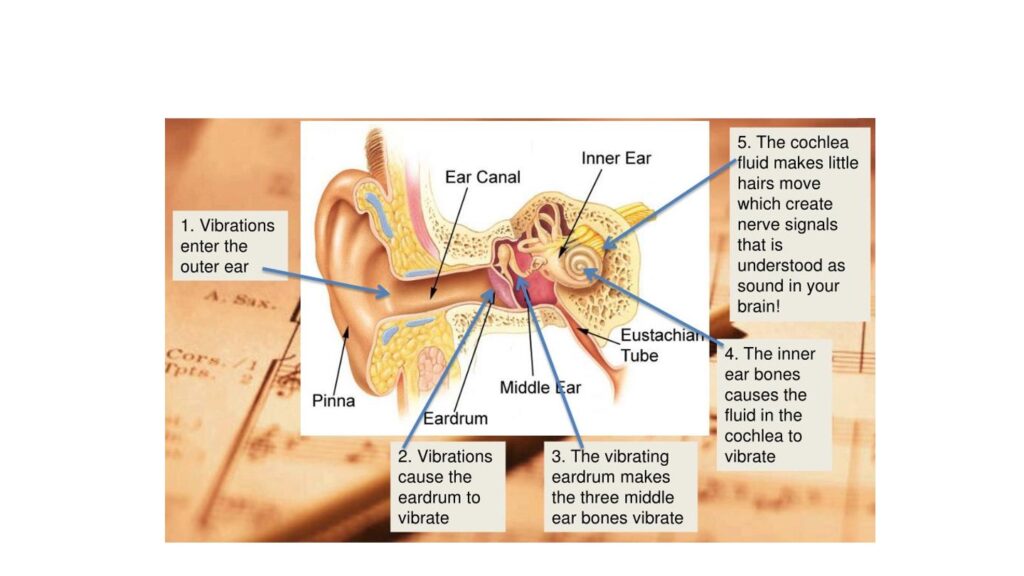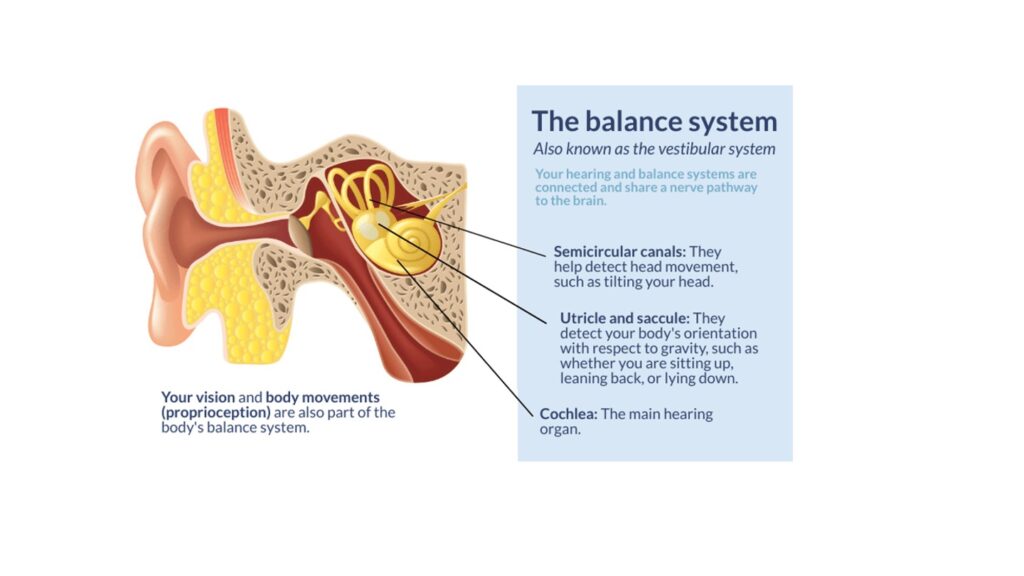How we hear sound

Sound is transmitted through the air as sound waves from the environment. The sound waves are funnelled by the outer ear down the ear canal to the eardrum.
The sound waves cause the eardrum to vibrate, which sets the three connected tiny bones, ossicles, in the middle ear into motion.
The motion of the three bones causes the fluid in the inner ear, or cochlea, to move.
The movement of the fluid in the inner ear causes the hair cells in the cochlea to bend with the movement and these change the movement into electrical impulses.
These electrical impulses are transmitted to the hearing (auditory) nerve and up to the brain, where they are interpreted as sound.
Here’s a really good and short (2.30min) explainer of how hearing works. You will way better understand hearing after watching it.
Parts of our hearing system
They come in all shapes and sizes. We tug on them, pierce them, cauliflower them and occasionally get a flea in them, but our main ear action is far from sight.
The Outer Ear
The part of the outer ear that we see is called the pinna, or auricle. The pinna, with its grooves and ridges, can provide a natural volume boost for sounds in the 2000 to 3000 Hz frequency range, where speech happens.
The ear canal is lined with only a few layers of skin and fine hair, with an abundant flow of blood to the ear canal.
Wax (cerumen) accumulates in the ear canal and serves as a protective barrier to the skin from bacteria and moisture. Ear wax is normal, unless it completely blocks the ear canal.
The Middle Ear
The eardrum (tympanic membrane) is the dividing structure between the outer and middle ear. Although it is an extremely thin membrane, the eardrum is made up of three layers to increase its strength.
The eardrum contains three tiny bones called ossicles and these three bones form a connected chain in the middle ear. The ossicles take mechanical vibrations received at the tympanic membrane into the inner ear.
The Eustachian tube is the middle ear’s air pressure equalizing system. The middle ear is encased in bone and does not associate with outside air except through the Eustachian tube.
This tubular structure is normally closed, but it can be involuntarily opened by swallowing, yawning, or chewing. It can also be intentionally opened to equalize pressure in the ears, such as when flying in an airplane. When this happens, you often hear a soft popping sound.
Loud noises or sudden changes in pressure (eg when scuba diving) can cause a hole in the eardrum, often referred to casually as a burst eardrum. These generally heal naturally.
The Inner Ear
The inner ear is an organ located deep within the skull bone and has two main structures: the semicircular canals and the cochlea.
- Cochlea – This is the hearing organ of the inner ear, which is a fluid-filled structure that looks like a snail. The cochlea changes the mechanical vibrations from the tympanic membrane and the ossicles into a sequence of electrical impulses. Sensory cells, called hair cells, bend in the cochlea as the fluid is disrupted by the mechanical vibrations. This bending of the hair cells causes electrical signals to be sent to the brain by way of the auditory nerve.
- Semicircular canals – These structures do not contribute to hearing, but assist in maintaining balance as we move.

Keeping things in balance
Our balance system keeps us walking and moving without falling or feeling dizzy. When it’s all good, we don’t even realise what is happening or how it works.
The human balance system—also known as the vestibular system—is complicated. Our brain relies primarily on information from three sources:
- the tiny vestibular organs located in the inner ear
- our eyes
- sensations in our legs and feet (formally known as proprioception)
Balance organs in the inner ear
- The three semicircular canals: These canals are filled with fluid. As you rotate your head, the fluid causes cupula—sail-like structures at the end of the canals—to move, bending hair cells, according to the National Institute on Deafness and Other Communication Disorders (NIDCD).
- Two otolith organs (utricle and saccule): Inside these organs are tiny stones, known as otoconia, that move in response to gravity. This is how your brain knows whether you are standing up or lying down, for example.
Hearing and balance are both part of the inner ear
The inner ear is the same part of the ear where the cochlea—the snail-like organ where soundwaves get converted into electrical impulses and transmitted to the brain—is situated. Our hearing system and our balance organs share a nerve pathway to the brain, the vestibulocochlear nerve.
With our hearing and balance systems so close, sometimes a problem with one can be a problem with the other as well. People who have hearing loss are much more likely to have balance disorders than those who do not have hearing loss.
If you have a balance disorder, you may experience a variety of symptoms, including dizziness, vertigo, feeling faint, falling (or feeling as though you will), and probably a little confusion as well. Talk to your doctor about these issues and they can start the process of testing (there are a range of next step experts you can be guided to) and start sorting things out.


